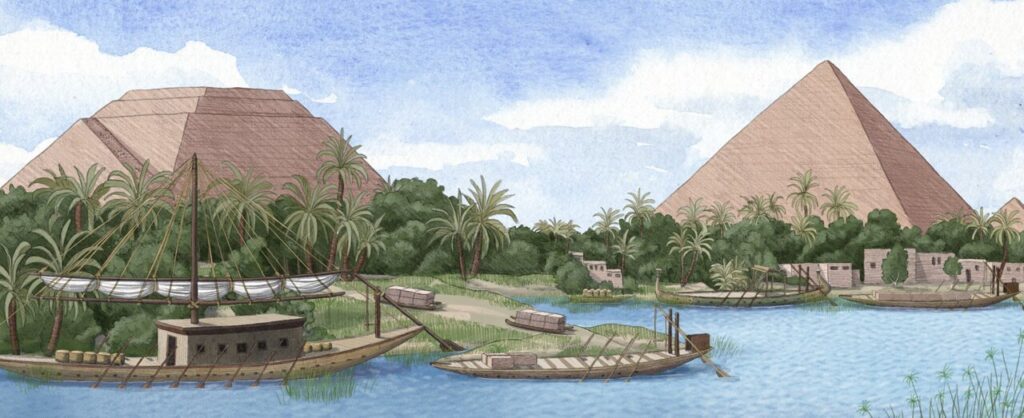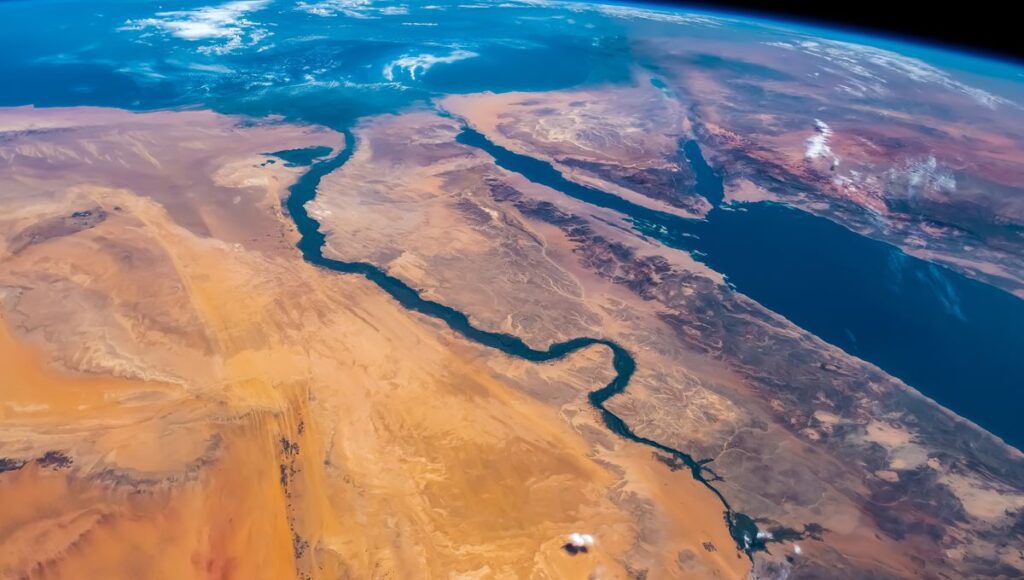
Introduction
The River Nile has been central to the development of ancient civilizations in northeastern Africa, particularly ancient Egypt. Its consistent flooding cycle provided the fertile soil necessary for agriculture, supporting the growth of one of history’s most remarkable civilizations. Recent studies have unearthed crucial shifts in the Nile’s evolution during ancient Egypt, revealing how these changes influenced the socio-economic and cultural dynamics of the region. This article explores these findings, detailing the scientific methods used, the implications for our understanding of ancient Egypt, and the broader significance for environmental and historical research.
The Importance of the Nile in Ancient Egypt
The Lifeline of a Civilization
Nile River: 6,650 km long, lifeblood of Egypt for millennia. “The Nile River’s annual floods created fertile land for farming, facilitating agriculture, transportation, and trade. The Nile’s predictable flooding cycle enabled Egyptians to develop a calendar and agricultural practices for food security and societal stability.
Cultural and Religious Significance
The Nile also held immense cultural and religious significance for ancient Egyptians. The ancient Egyptians revered the Nile as a divine gift, linked to the god Hapi, who controlled the annual floods. The river was central to Egyptian mythology and was often depicted in art and literature. Its importance is underscored by the fact that many major cities, including Thebes and Memphis, were located along its banks.
Geological and Climatic Context
Geological Formation
The geological history of the Nile is complex, shaped by tectonic activity, climatic changes, and river dynamics over millions of years. The Nile’s course has shifted numerous times due to these factors, leading to the creation of various river channels and floodplains. Understanding these geological processes is crucial for reconstructing the ancient river’s behavior and its impact on human societies.
Climatic Influences
Climatic changes have played a significant role in the evolution of the Nile. Periods of increased rainfall in the Ethiopian Highlands, where the Blue Nile originates, led to higher river discharge and more substantial flooding. Conversely, drier periods resulted in reduced water flow and less fertile floodplains. These climatic fluctuations influenced agricultural productivity and, consequently, the prosperity of ancient Egyptian civilization.
Recent Discoveries in the Nile’s Evolution
New Geological and Archaeological Evidence
Recent multidisciplinary research has provided new insights into the Nile’s evolution during ancient Egypt. Using advanced techniques such as sediment analysis, radiocarbon dating, and paleoclimatic reconstructions, scientists have uncovered evidence of significant shifts in the river’s course and flooding patterns.
Sediment Analysis
Sediment cores taken from various locations along the Nile have revealed layers corresponding to different historical periods. By analyzing the composition and deposition rates of these sediments, researchers can infer changes in river dynamics and flooding patterns. For instance, a study by Stanley and Warne (1998) showed that significant sedimentary changes occurred around 4,200 years ago, coinciding with a period of climatic instability known as the 4.2-kiloyear event.
Radiocarbon Dating
Radiocarbon dating of organic materials found within sediment layers has helped establish a timeline for these changes. This method allows for precise dating of events and correlations with historical records. Research conducted by Woodward et al. (2015) demonstrated that major shifts in the Nile’s flow patterns occurred during critical periods of ancient Egyptian history, such as the collapse of the Old Kingdom around 2,200 BCE.
Paleoclimatic Reconstructions
Paleoclimatic reconstructions using data from ice cores, tree rings, and other proxies provide a broader context for understanding how climatic changes influenced the Nile. These studies have shown that periods of increased rainfall in the Ethiopian Highlands, driven by shifts in the Intertropical Convergence Zone (ITCZ), correspond to periods of enhanced Nile flooding and agricultural productivity (Berke et al., 2012).
Implications for Ancient Egyptian Society
The findings of these studies have profound implications for our understanding of ancient Egyptian society. They suggest that the Nile’s evolution was closely linked to the rise and fall of different dynasties and periods of stability and instability.
Agricultural Productivity and Population Growth
Changes in the Nile’s flooding patterns directly impacted agricultural productivity, which in turn influenced population growth and urban development. Periods of stable, predictable flooding allowed for the expansion of agricultural lands and the growth of cities. Conversely, periods of reduced flooding or erratic behavior likely led to food shortages, social unrest, and political instability.
Political and Economic Stability
The prosperity of ancient Egyptian civilization was heavily dependent on the Nile’s behavior. Dynastic changes, including the transitions between the Old, Middle, and New Kingdoms, often coincided with shifts in the river’s dynamics. For example, the decline of the Old Kingdom around 2,200 BCE has been linked to a period of reduced Nile flooding, leading to agricultural decline and social upheaval (Hassan, 1997).
Cultural and Religious Adaptations
The Nile’s changing behavior also influenced cultural and religious practices. The annual inundation was a central aspect of Egyptian cosmology, and shifts in its patterns may have prompted changes in religious rituals and beliefs. The construction of monumental architecture, such as the pyramids, was closely tied to the agricultural calendar, and changes in the Nile’s flooding could have affected these activities.
Scientific Methods and Techniques
Sediment Core Analysis
Sediment core analysis involves extracting cylindrical samples of sediment from the riverbed or floodplain. These cores are then analyzed for their physical, chemical, and biological properties, providing a record of past environmental conditions.
Grain Size and Composition
Grain size and composition analysis can reveal information about past river flow conditions. Coarser sediments typically indicate periods of higher flow, while finer sediments suggest lower flow or calm water conditions. By examining changes in sediment grain size over time, researchers can infer shifts in the Nile’s flooding intensity and frequency (Stanley & Warne, 1998).
Organic and Inorganic Content
The organic and inorganic content of sediment cores can provide insights into past vegetation, soil erosion, and human activity. Higher organic content often corresponds to periods of increased vegetation and wetter conditions, while higher inorganic content may indicate soil erosion and drier conditions. These analyses help reconstruct the environmental conditions that influenced the Nile’s evolution.
Radiocarbon Dating
Radiocarbon dating is a crucial technique for establishing a timeline of environmental changes. It involves measuring the decay of carbon-14 isotopes in organic materials, such as plant remains or charcoal, to determine their age.
Sample Collection and Preparation
Samples for radiocarbon dating are carefully collected from sediment cores, ensuring that they are not contaminated by more recent materials. These samples are then prepared and processed to extract the carbon content for dating.
Calibration and Analysis
Radiocarbon dates are calibrated using known age markers, such as tree rings or historical records, to account for variations in atmospheric carbon-14 levels. This calibration provides accurate dates for environmental events, allowing researchers to correlate them with historical periods and climatic changes (Woodward et al., 2015).
Paleoclimatic Reconstructions
Paleoclimatic reconstructions use a variety of proxies to infer past climate conditions. These proxies include ice cores, tree rings, pollen records, and speleothems (cave formations).
Ice Core Data
Ice cores from polar regions contain trapped air bubbles that provide a record of past atmospheric composition and temperature. By analyzing the isotopic composition of these bubbles, researchers can infer past climate conditions, including changes in precipitation patterns that affected the Nile.
Tree Rings
Tree rings provide annual records of growth conditions, reflecting changes in temperature and precipitation. By examining tree rings from regions influenced by the Nile’s watershed, scientists can reconstruct past climatic conditions and their impact on the river’s flow.
Pollen Records
Pollen records from sediment cores provide information about past vegetation and climate conditions. By identifying the types and abundance of pollen grains, researchers can infer changes in vegetation cover and climate conditions over time.

Implications for Environmental and Historical Research
Understanding Ancient Climate Change
The study of the Nile’s evolution during ancient Egypt provides valuable insights into past climate change and its impacts on human societies. By reconstructing the Nile’s behavior and correlating it with historical events, researchers can better understand how climatic fluctuations influenced the development and decline of ancient civilizations.
Lessons for Modern Climate Adaptation
The findings from this research also have implications for modern climate adaptation. Ancient Egyptian society was remarkably resilient in the face of climatic challenges, developing sophisticated irrigation and agricultural practices to manage the Nile’s flooding. Studying these adaptations can provide valuable lessons for modern societies facing similar challenges due to climate change.
Interdisciplinary Approaches
The research on the Nile’s evolution highlights the importance of interdisciplinary approaches in environmental and historical research. By combining geological, climatic, archaeological, and historical data, scientists can develop comprehensive understandings of past environmental changes and their impacts on human societies. This interdisciplinary approach can be applied to other regions and time periods, enhancing our knowledge of human-environment interactions.
Future Research Directions
Continued Exploration of the Nile’s Evolution
Future research will continue to explore the Nile’s evolution using advanced techniques and new data sources. This research will aim to refine our understanding of the timing and magnitude of past environmental changes and their impacts on ancient Egyptian society.
Integration of New Technologies
New technologies, such as remote sensing and geographic information systems (GIS), will enhance the ability to study the Nile’s evolution. These technologies can provide high-resolution data on river dynamics, landscape changes, and archaeological sites, facilitating more detailed and accurate reconstructions.
Comparative Studies on Nile’s evolution during ancient Egypt
Comparative studies of other major river systems and ancient civilizations can provide additional insights into the interactions between environmental changes and human societies. By comparing the Nile’s evolution with other rivers, such as the Tigris-Euphrates or the Indus, researchers can identify common patterns and unique adaptations.
Public Engagement and Education
Engaging the public and educating communities about the importance of understanding past environmental changes is crucial. By sharing the findings from research on the Nile’s evolution, scientists can raise awareness about the impacts of climate change and the need for sustainable management of water resources.
Conclusion
The discovery of a crucial shift in the River Nile’s evolution during ancient Egypt has profound implications for our understanding of the region’s history and environmental dynamics. Through the use of advanced scientific methods and interdisciplinary research, scientists have uncovered evidence of significant changes in the Nile’s behavior and their impacts on ancient Egyptian society. These findings highlight the intricate interplay between climate, environment, and human development, offering valuable lessons for modern climate adaptation and resilience. As research continues, the study of the Nile’s evolution will undoubtedly contribute to our broader knowledge of human-environment interactions and the enduring legacy of ancient civilizations.


Don’t think anyone’s going to south Sudan for tourism at the moment. It’s pretty conflict riven and dangerous for the past few years.